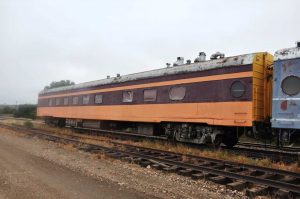The buffeteria cars were initially designed for use with special group movements and entered service in July 1964. They were then used on both special and regular trains. In September 1965 the Morning Hiawatha between Chicago and the Twin Cities had its diner service modified from regular diners to buffeteria service. The cars saved money since they used a smaller staff than a regular diner.
After Amtrak was created in 1971, No. 126 was sold into private ownership, and the current owner is donating the car to IRM. It is in complete and in original condition. $25,000 is needed to move the car by rail and begin restoration work.
To donate to the buffeteria car movement and restoration go to www.irm.org.
The movement and restoration of the buffeteria is one of many projects the museum is planning in 2019. A 2018 acquisition, former Toledo, Peoria & Western Alco C424 No. 800, is expected to arrive at the museum this week. The unit was acquired from the Morristown & Erie and is being moved from New Jersey to the museum. “Last year was a slow year for acquisitions,” Executive Director Nick Kallas says. “Acquisitions are getting harder because of costs. We still have some pieces out there (such as No. 126) that we’ve bought but haven’t shipped yet, and we are still working to get them out.” The museum now has more than 475 pieces of equipment.
Paid attendance at the museum in 2018 kept up with 2017 at about 70,000 visitors, but that is not a complete figure since the museum has free attendance during two months that are slow periods and the museum doesn’t count those visitors.
Attendance at the museum’s Thomas the Tank engine event was down slightly, by 500 visitors out of 27,000. The museum’s “Happy Holiday Railway” Christmas train event almost doubled to around 18,000 passengers. In 2019 the museum will expand its popular “Bunny Trolley Hop” around Easter from one to two days, Kallas says.
This year work will begin on two new building that will be part of the museum’s circa 1958 “Midwest Main Street” scene. One building will be used to house the Pullman Library Collection, presently housed in downtown Union. Another part of the building will have a model railroad, while another portion will be used by the Milwaukee Road Historical Association. A second building will house the Chicago & North Western Historical Society archives. Kallas says ground should be broken on both buildings this year.
Restoration work is moving ahead on several fronts. The museum has heated restoration shop buildings for each of its departments: steam, diesel, and electric, and work goes on year round. In 2018, J. Neils Lumber Co. Shay No. 5 was fired up for the first time since 1999. It is expected to enter service in the latter part of the season. The Diesel Department plans on repainting at least one locomotive in 2019 following completion last year of Rock Island GP7R No. 4506 in the “Bankruptcy Blue” scheme Rock Island painted its diesels following its 1975 bankruptcy. The Electric Department is working on several restorations and Kallas said he expects a couple of cars to enter service this year. Repairs to the truck and traction motors on the famous Chicago North Shore & Milwaukee Electroliner should be completed this year. The museum is fabricating three new bearings for the articulation joints between the cars. Kallas says he hopes the car will be put together in time to be displayed at the museum’s annual Trolley Pageant in July.















Amazon customers, AMAZONSMILE.
The IRM is well run and welcomes competent volunteers. Those interested in a specific subject might inquire. Contact Bob Storozuk at MRHA.com if the Milwaukee Rd. fits.
A cursory look at the pix. reveals the bit of skirting to reduce drag and the Nystrom high speed trucks.
Sounds like I will need to make plans to head to IRM later this summer. As for paint scheme names I felt the Australians were always good at classifying their paint schemes, using terms like “Candy”, “Cheeseburger”, Mustard Pot”, and “Red Terror” to describe the paint applied by various operators over the years.
I never understood why The Rock created the new image blue and white color scheme when the $$$ should have been spent on the infrastructure instead.
An Iowa newspaper characterized the Rock Island’s new blue paint scheme at the time as an “attempt to hide red ink behind blue paint”.
It’s good to see a rail museum with an active and viable program of acquisition, restoration, and maintenance. May they be able to continue what they have done so well for so long.
LOL, Bankruptcy Blue Scheme. That is a new term on me, makes sense. New livery was introduced at that time.